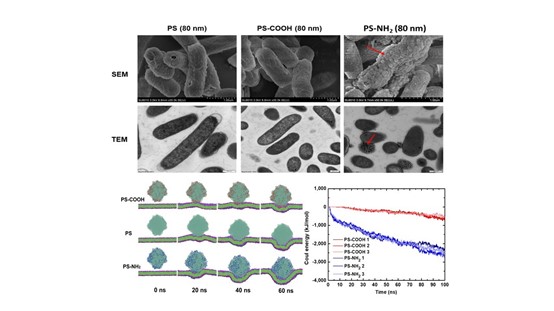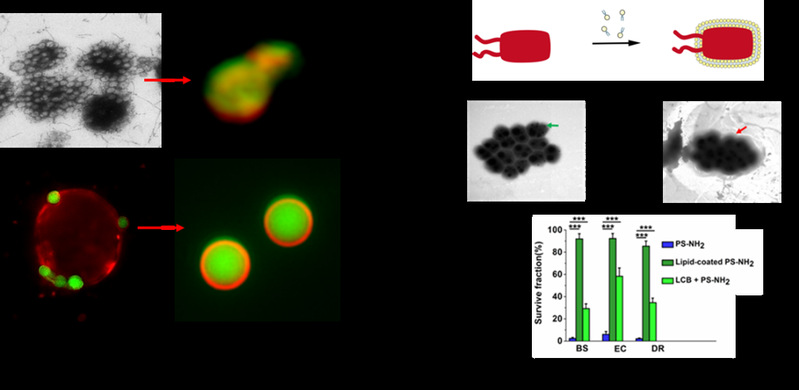Plastics, as an important basic material, have profoundly influenced the development of modern industry and have penetrated into all areas of people's lives. At the same time, however, their widespread use has led to a serious global pollution problem that needs to be addressed. Due to solar radiation and slow biodegradation, plastics in the environment can break down into microplastics (1 μm - 5 mm), submicroplastics (100 nm - 1 μm) and further into nanoplastics (1 - 100 nm). Compared to large plastic contaminants, nanoplastics are easily absorbed and accumulated by human tissues, leading to serious health risks. On the other hand, bacteria, which are ubiquitous in nature and play an important role in the ecosystem, are involved in the decomposition and differentiation of plastics and have an important impact on their recycling in the ecosystem. Therefore, it is important to understand how nanoplastics interact with bacterial cell membranes to understand their uptake processes and to fathom the associated risks to ecosystem health and human flora.
On April 16, 2022, Prof. Ruhong Zhou from Zhejiang University Shanghai Institute for Advanced Study, Prof. Yuejin Hua and Prof. Bing Tian from the College of Life Sciences, Zhejiang University, published a paper titled Distinct lipid membrane interaction and uptake of differentially sensitive bacterial membranes (https://doi.org/10.1186/s12951-022-01321-z) in Journal of Nanobiotechnology, a top-tier journal in the field of nanobiotechnology. The study reveals for the first time the mechanism of transmembrane endocytosis of nanoplastics on bacterial cell membranes. The results show that the entry of nanoplastics into bacteria depends on the surface charge of the nanoplastics and the structural properties of the cell membranes. Among them, the positively charged polystyrene nanoplastics (PS -NH2, 80 nm) can effectively penetrate the cell membrane, while the negatively charged nanoplastics PS-COOH and the neutral nanoplastics PS have difficulty entering the cell through the membrane. To understand the molecular mechanism, the authors used coarse-grained molecular dynamics simulations to study the interaction between nanoplastics with different charge properties and the bacterial cell membrane. They found that the extent of adsorption endocytosis PS -NH2 > PS > PS-COOH and PS -NH2 caused more disruption of cell membrane order. The simulation results suggest that the strong electrostatic interaction between PS -NH2 and the cell membrane promotes adsorption and the endocytosis process.

The positively charged nanoplastic PS -NH2 exerts greater tension on cell membranes, causing membrane deformation and disruption and inducing the production of reactive oxygen species (ROS), leading to bacterial rupture and death. Interestingly, the subsequently released membrane lipid-coated nanoplastic is virtually nontoxic to the cells. Based on this, the authors coated the bacteria with artificial phospholipids and found that the invisible bacteria were resistant to the positively charged nanoplastics, suggesting that the membrane lipids may shield the nanoplastics from the strong electrostatic interactions with the cells. The research findings provide new ideas for assessing the health risks of nanoplastics and for biocontrol of micro- and nanoplastic contaminants.

This work was partially supported by the National Natural Science Foundation of China, the National Key R&D Program of China, the National Independent Innovation Demonstration Zone Shanghai Zhangjiang Major Projects, the Starry Night Science Fund of Zhejiang University Shanghai Institute for Advanced Study, and BirenTech Research. The authors also acknowledge the financial support from W. M. Keck Foundation. The article and supplementary materials could be accessed at Distinct lipid membrane interaction and uptake of differentially charged nanoplastics in bacteria | Journal of Nanobiotechnology | Full Text (biomedcentral.com).
About SIAS
Shanghai Institute for Advanced Study of Zhejiang University (SIAS) is a jointly launched new institution of research and development by Shanghai Municipal Government and Zhejiang University in June, 2020. The platform represents an intersection of technology and economic development, serving as a market leading trail blazer to cultivate a novel community for innovation amongst enterprises.
SIAS is seeking top talents working on the frontiers of computational sciences who can envision and actualize a research program that will bring out new solutions to areas include, but not limited to, Artificial Intelligence, Computational Biology, Computational Engineering and Fintech.

